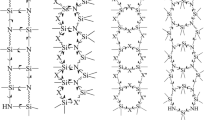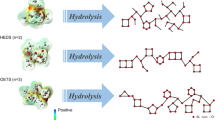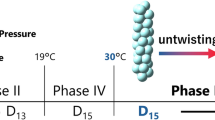Abstract
One of four possible stereoisomers of a methyl(trifluoropropyl)siloxane cyclic tetramer was isolated from low molecular weight volatiles, formed in a reaction mixture during ring-opening/equilibration polymerization of methyl(3,3,3-trifluoropropyl)cyclotrisiloxane (D3F). The crystalline solid was recognized as resembling a previously isolated cyclic siloxane with undetermined stereochemistry, assigned as a cyclotetrasiloxane by IR spectroscopy, and then further characterized by multinuclear (1H, 13C, 19F, and 29Si) NMR spectroscopy as a relatively high symmetry species with respect to the potential cis–trans relationships of the methyl and 3,3,3-trifluoropropyl substituents at Si. Unambiguous characterization and assignment of the stereochemistry was accomplished by a single crystal X-ray diffraction study, which revealed the compound was the trans, trans, trans-isomer, one species in these equilibration polymerization mixtures. The single crystal X-ray structure of the related, commercially important trans-D3F cyclotrisiloxane has also been determined. The structures of the two cyclic fluorinated siloxanes are discussed with respect to each other, and in the context of prototypical structures for these common Si3O3 and Si4O4 ring systems.
Similar content being viewed by others
Data Availability
The data generated and/or analyzed during the current study are available from the corresponding author on reasonable request, but please read the supplementary information of this article prior to any request. Crystallographic data for 1 and 2 in this article have been deposited at the Cambridge Crystallographic Data Centre, under numbers CCDC 2296541 (1) and 2296540 (2). Copies of the data can be obtained free of charge via https://www.ccdc.cam.ac.uk/structures/. All other data generated and analyzed during this study, which include experimental and spectroscopic data, are included in this article and its supplementary information.
References
Tarrant P, Dyckes DW, Dunmire R, Butler GB (1957) The preparation of some fluoroalkylmethyldichlorosilanes and their hydrolysis products. J Am Chem Soc 79:6536–6540
Pasquet C, Longuet C, Hamdani-Devarennes S, Ameduri B, Ganachaud F (2012) Comparison of surface and bulk properties of pendant and hybrid fluorosilicones. In Silicone Surface Science, Springer, 115–178
Owen MJ (2000) Surface properties and applications. In Silicone-containing polymers, the science and technology of their synthesis and applications, Springer, 213–231
Boutevin B, Guida-Pietrasanta F, Ratsimihety A (2000) Side group modified polysiloxanes. In Silicon-containing polymers, the science and technology of their synthesis and applications, Springer, 79–112
Breunig S, Chardon J, Guennouni N, Mignani G, Olier P, Derspuy AV, Vergelati C (2005) Poly‐functionalization of polysiloxanes — New industrial opportunities. In Organosilicon chemistry set: From molecules to materials, Wiley 645–658
Pierce OR, Holbrook GW, Johannson OK, Saylor JC, Brown ED (1960) Fluorosilicone Rubber. Ind Eng Chem 52:783–784
Midland Silicones Ltd. (1960) GB Patent No. 832,487
Pierce OR, Holbrook GW (1961) US Patent No. 2,979,519 assigned to Dow-Corning
Klebanskii AL, Yuzhelevski YA, Kogan EV, Kagan EG (1962) The isomerism of 1,3,5-tris(3,3,3-trifluoropropyl)-1,3,5-trimethylcyclotrisiloxane. Russ J Gen Chem (Engl Transl) 32:320
Burshtein LL, Yuzhelevski YA, Kogan EV, Klebanskii AL (1963) The structure of isomers of 1,3,5-tris(3,3,3-trifluoropropyl)-1,3,5-trimethylcyclotrisiloxane. Russ J Gen Chem (Engl Transl) 33:2716
Yuzhelevski YA, Kogan EV, Klebanskii AL, Larionova ON (1964) The isomerism of 3,3,3-trifluoropropylmethylcyclosiloxanes. Russ J Gen Chem (Engl Transl) 34:1794–1795
Kuo C-M, Saam JC, Taylor RB (1994) Stereoregularity of poly[methyl(3,3,3-trifluoropropylsiloxane. Polym Int 33:187–195
Collins WT, Kuo C-M, Saam JC (1995) US Patent No. 5,401,822 assigned to Dow-Corning
For convenience, we adopt here the “General Electric” shorthand nomenclature commonly used in the silicone industry, where “Dx” represents a difunctional -[(CH3)2SiO]x- moiety, and by analogy, “DxF” represents a -[CF3C2H4(CH3)SiO]x- repeat unit. For details see Wilcock DF (1947) Liquid methylpolysiloxane systems. J Am Chem Soc 69:477-486
Battjes KP, Kuo CM, Miller RL, Saam JC (1995) Strain-induced crystallization in poly[methyl(3,3,3-trifluoropropyl)siloxane] networks. Macromolecules 28:790–792
Kuo CM, Battjes KP, Miller RL, Saam JC (1997) Strain induced crystallization in stereoregular poly methyl(3,3,3-trifluoropropyl) siloxane networks. Rubber Chem Technol 70:769–780
Owen MJ (2014) Poly[methyl(3,3,3-trifluoropropyl)siloxane]. Handbook of Fluoropolymer Science and Technology, 183–200. https://doi.org/10.1002/9781118850220
Yang Z, Bai Y, Meng L, Wang Y, Pang A, Guo X, **ao J, Li W (2022) A review of poly[(3,3,3-trifluoropropyl)methylsiloxane]: Synthesis, properties and applications. Eur Polymer J 163:110903. https://doi.org/10.1016/j.eurpolymj.2021.110903
Nakamura K, Refojo MF, Crabtree DV, Leong F-L (1990) Analysis and fractionation of silicone and fluorosilicone oils for intraocular use. Invest Ophthalmol Vis Sci 31:2059–2069
McLachlan MS, Kierkegaard A, Radke M, Sobek A, Malmvärn A, Alsberg T, Arnot JA, Brown TN, Wania F, Breivik K, Xu S (2014) Using model-based screening to help discover unknown environmental contaminants. Environ Sci Technol 48:7264–7271
Zhi L, Xu L, Qu Y, Zhang C, Cao D, Cai Y (2018) Identification and elimination of fluorinated methylsiloxanes in environmental matrices near a manufacturing plant in eastern China. Environ Sci Technol 52:12235–12243. https://doi.org/10.1021/acs.est.8b02508
Huang Z, **ang X, Xu L, Cai Y (2020) Phenylmethylsiloxanes and trifluoropropylmethylsiloxanes in municipal sludges from wastewater treatment plants in China: Their distribution, degradation and risk assessment. Water Res 185:116224
Zhi L, Sun H, Xu L, Cai Y (2021) Distribution and elimination of trifluoropropylmethylsiloxane oligomers in both biosolid-amended soils and earthworms. Environ Sci Technol 55:985–993. https://doi.org/10.1021/acs.est.0c05443
In the context of environmental contaminants with multiple isomeric forms, the presence or absence of which (as well as their relative distributions) may be source or process dependent, it is desirable to have more definitive identification of specific stereoisomers. In this way, the ultimate source of the pollution, and perhaps even different rates/mechanisms of degradation of the isomers, may be more readily identified
Fulmer GR, Miller AJM, Sherden NH, Gottlieb HE, Nudelman A, Stoltz BM, Bercaw JE, Goldberg KI (2010) NMR chemical shifts of trace impurities: Common laboratory solvents, organics, and gases in deuterated solvents relevant to the organometallic chemist. Organometallics 29:2176–2179
Bruno TJ, Svoronos PDN (2011) Handbook of Basic Tables for Chemical Analysis, 3rd edn. CRC Press, New York, pp 553–555
Dolomanov OV, Bourhis LJ, Gildea RJ, Howard JAK, Puschmann H (2009) OLEX2: a complete structure solution, refinement and analysis program. J Appl Cryst 42:339–341
Sheldrick GM (2015) SHELXT – Integrated space-group and crystal structure determination. Acta Cryst A71:3–8
Sheldrick GM (2015) Crystal structure refinement with SHELXL. Acta Cryst C71:3–8
Brown ED, Carmichael JB (1965) Cyclics distribution in 3,3,3-trifluoropropylmethylsiloxane polymers. J Poly Sci B Polymer Lett 3:473–482
Wright N, Hunter MJ (1947) Organosilicon polymers. III. Infrared spectra of the methylpolysiloxanes. J Am Chem Soc 69:803–809
Young CW, Servais PC, Currie CC, Hunter MJ (1948) Organosilicon polymers. IV. Infrared studies on cyclic disubstituted siloxanes. J Am Chem Soc 70:3758–3764
The original literature (Ref 25) gave these distinctive band ranges as 1010–1020 cm-1 for diorgano-substituted cyclotrisiloxanes and 1081–1093 cm-1 for diorgano-substituted cyclotetrasiloxanes. Compound 1, with the corresponding strongest IR band appearing at 1030 cm-1, falls between these two reported ranges, but in fact is closer to the higher end of the wavenumber range associated with cyclotrisiloxanes. The assignment of Compound 1 as a cyclotetrasiloxane by IR spectroscopy was therefore somewhat indeterminant until further (this current) work was done. Resolution of this anomaly with the historical literature was accomplished by comparison to spectra acquired on our lab instrumentation, using genuine D3F, D3, and D4 as reference materials. See the Supplementary Material for more details
Lewis RN (1948) Methylphenylpolysiloxanes. J Am Chem Soc 70:1115–1117
Ahn HW, Clarson SJ (2002) Synthesis and characterization of cis and trans trimethyltriphenylcyclotrisiloxane. J Inorg Organomet Polymers 11:203–216
Jiang K, Ni Y, Qiu H, Li M, Jiang J, Lai G (2006) Separation of the isomers of oligomethylphenyl-cyclosiloxanes and determination of their structures by capillary GC-MS. Chromatographia 64:689–694
The GC-MS ion chromatogram is found in Figure S1 of the Supplementary Information addendum for Ref 14. GC retention times with labeled structural drawings for each assigned isomer are in Table S1 in the Supplementary Information for Ref 16
Pestunovich VA, Larin MF, Voronkov MG, Engelhardt G, Jancke H, Mileshkevich VP, Yuzhelevskii YA (1977) 29Si NMR spectroscopy of cyclosiloxanes. Journal of Structural Chemistry (English translation) 18:463–470
Belyakova NR, Mileshkevich VP (1990) Identification of stereoisomeric siloxanes from the signals of methyl groups in the PMR spectra. Russ J Gen Chem (Engl Transl) 60:2045–2048
Lin D, Willson TR, Haque ME, Vu AD, Dao K-LD, Tshita MM, Davis JM, Honeychuck RV (2000) Fluorinated siloxane amine oligomers. J Appl Poly Sci 78:1315–1320
Kälig H, Zoellner P, Mayer-Helm BX (2009) Characterization of degradation products of poly [(3,3,3-trifluoropropyl) methylsiloxane] by nuclear magnetic resonance spectroscopy, mass spectrometry and gas chromatography. Polym Degrad Stab 94:1254–1260
Zhang G-D, Hu Y-Q, Wu J-R, Li J-Y, Lai G-Q, Zhong M-Q (2016) Improved synthesis and properties of hydroxyl-terminated liquid fluorosilicone. J Appl Poly Sci 133:43220. https://doi.org/10.1002/APP.43220
These spectra were also taken in the same acetone-d6 solvent as in this work, so solvent effects are unlikely to be the cause of the lack of correspondence in chemical shift
It should be noted that in the 29Si NMR experimental data cited, the spectra were measured on a low-field (100 MHz 1H-resonance frequency, ≈ 2.35 Tesla field strength) instrument, which may have limited resolution of all the isomers present. The spectra were also acquired in CCl4, which might obviate direct comparison of chemical shift data with this work (in acetone-d6) due to solvent-effects
In reality, symmetry inequivalent atoms in a structure may not be present in sufficiently different magnetic environments to be resolved in the NMR spectrum as observable chemical shift differences or specific spin-spin splittings dictated by that inequivalence. As an example, the 75 MHz 29Si-NMR spectrum of the commercial cis- and trans-D3F mixture, with three different Si-methyl or 3,3,3-trifluoropropyl group environments, was not resolvable into distinct resonances for the two isomeric forms, much less distinguishing the two equivalent ring sub-units from the third one in the trans-isomer. See Ref. 33
You Y, Chen J, Zheng A, Wei D, Xu X, Guan Y (2020) Effect of silanol on the thermal stability of poly[methyl(trifluoropropyl)siloxane]. J Appl Poly Sci 137:e49347. https://doi.org/10.1002/app.49347
Steinfink H, Post B, Fankuchen I (1955) The crystal structure of octamethyl cyclotetrasiloxane. Acta Cryst 8:420–424
Couzijn EPA, Lutz M, Spek AL, Lammertsma K (2009) 2,2,6,6-Tetrakis(biphenyl-2-yl)-4,4,8,8-tetramethylcyclotetrasiloxane. Acta Cryst E65:o2182–o2183
Malinovskii ST, Vallina AT, Stoeckli-Evans H (2007) X-ray diffraction investigation of siloxanes. III. Structure and configuration of cyclic tetra- and pentasiloxanes bearing different organic substituents at silicon atoms. J Struct Chem 48:128–136. Multiple methyl-methoxyphenyl derivatized cyclic tetrasiloxanes were reported
Shklover VE, Kalinin AE, Gusev AI, Bokii NG, Struchkov YuT, Andrianov KA, Petrova IM (1973) Crystalline structures of cyclic siloxanes: 1,1,2,2-Tetramethyl-3,3,4,4-tetraphenylcyclotetrasiloxane. Zh Strukt Khim 14:692–699
Hensen K, Gebhardt F, Kettner M, Pickel P, Bolte M (1997) Two cyclotetrasiloxanes at 143K. Acta Cryst C53:1867–1869. Both the octaphenylcyclotetrasiloxane and an unusual tetraspiro compound, cyclotetrasiloxane-2,4,6,8-tetraspiro-tetrakis(cyclopentane) [(C4H8)SiO]4, were reported
Beckers H, Brauer DJ, Biirger H, Gielen R, Moritz P (1996) Siloxanes and silylamines with fluoromethyl-methylsilicon groups: X-ray study of [CH2F(CH3)SiO]4. J Organomet Chem 511:293–298
Abe Y, Suyama K-I, Gunji T (2006) Synthesis and Structure of cis-trans-cis-1,3,5,7-tetraisocyanato-1,3,5,7 tetramethylcyclotetrasiloxane. Chem Lett 35:114–115
Egert E, Haase M, Klingebiel U, Lensch C, Schmidt D, Sheldrick G (1986) Unusual conformations of isoelectronic (SiO)4, (SiOSiN)2 and (SiN)4 rings. J Organomet Chem 315:19–25
Büschen T, Dietz W, Klingebiel U, Noltemeyer M, Schwerdtfeger Y (2007) Synthesis of fluorosilylenolates, aminosilylenolates, -ethers, and aldol condensates. Z Naturforsch 62b:1358–1370
Braga D, Zanotti G (1980) The room-temperature structure of octaphenylcyclotetra(siloxane) (OPCTS). Acta Cryst B 36:950–953
Hossain MA, Hursthouse MB, Malik KMA (1979) Octaphenylcyclotetrasiloxane: The monoclinic form. Acta Cryst B35:522–524
Grey IE, Hardie MJ, Ness TJ, Raston CL (1999) Octaphenylcyclotetrasiloxane confinement of C60 into double columnar arrays. Chem Commun 1139–1140. https://doi.org/10.1039/a901719d
Albright A, Gawley RE (2011) NHC-catalyzed dehydrogenative self-coupling of diphenylsilane: A facile synthesis of octaphenylcyclotetra(siloxane). Tet Lett 52:6130. https://doi.org/10.1016/j.tetlet.2011.09.028
Nataro C, Cleaver WM, Allen CW (2009) 1-Methyl-1-vinyl-3,3,5,5-tetraphenylcyclotrisiloxane: An organofunctional cyclotrisiloxane. J Inorg Organomet Polym 19:566–569
Aggarwal EH, Bauer SH (1950) The structure of hexamethylcyclotrisiloxane as determined by diffraction of electrons on the vapor. J Chem Phys 18:42–50
Peyronel G (1954) Struttura cristallina dell’Esametilciclotrisilossano, Nota III. Rendiconti Accademia Nazionale Dei Lincei Classe di Scienze Fisiche. Matematiche e Naturali 16:231–236
Acknowledgements
The NSF is gratefully acknowledged for support of the acquisition of an X-ray diffractometer (Award Number 2117596) through the Major Research Instrumentation program.
Funding
The authors declare that no funds, grants, or other support were received during the preparation of this manuscript.
Author information
Authors and Affiliations
Contributions
The original concept of this paper was proposed by Dr. Leman. Synthesis, isolation and partial characterization of 1 was performed by Dr. Leman. Dr. Gibson performed all NMR characterization; Dr. Bonitatibus collected X-ray crystallographic data and refined the structures. The co-authors shared writing activities. All authors consent to publication of the work in its current form.
Corresponding author
Ethics declarations
Ethics Approval
The authors declare that there were no ethical issues during this research.
Consent to Participate
All the authors consent to participate in this research.
Consent to Publication
All the authors consent to the publication of this research.
Competing Interests
The authors declare no competing interests.
Additional information
Publisher's Note
Springer Nature remains neutral with regard to jurisdictional claims in published maps and institutional affiliations.
Supplementary Information
Below is the link to the electronic supplementary material.
Rights and permissions
Springer Nature or its licensor (e.g. a society or other partner) holds exclusive rights to this article under a publishing agreement with the author(s) or other rightsholder(s); author self-archiving of the accepted manuscript version of this article is solely governed by the terms of such publishing agreement and applicable law.
About this article
Cite this article
Leman, J.T., Gibson, J. & Bonitatibus, P.J. Characterization and Structure of Trans, Trans, Trans-1,3,5,7-Tetrakis(3ʹ,3ʹ,3ʹ-Trifluoropropyl)-1,3,5,7-Tetramethylcyclotetrasiloxane, and Structure of Trans-1,3,5-(3ʹ,3ʹ,3ʹ-Trifluoropropyl)-1,3,5-Trimethylcyclotrisiloxane. Silicon 16, 1491–1500 (2024). https://doi.org/10.1007/s12633-023-02768-x
Received:
Accepted:
Published:
Issue Date:
DOI: https://doi.org/10.1007/s12633-023-02768-x




